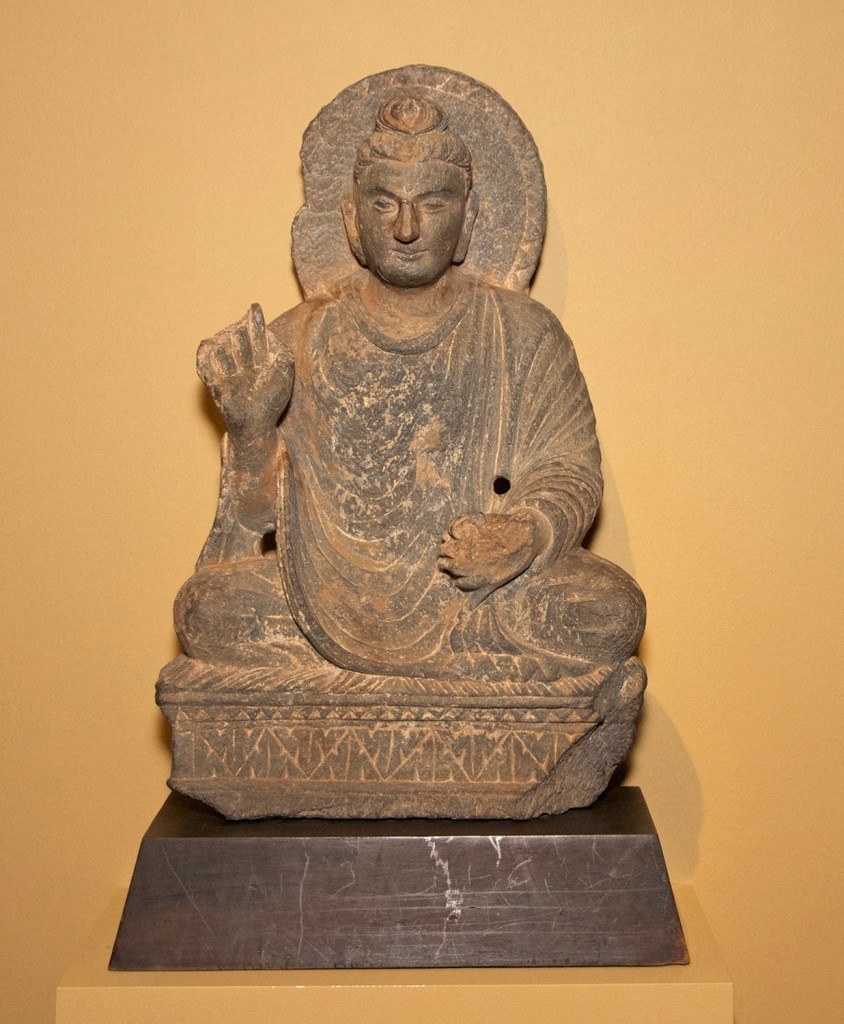
Anonymous
India, Gandhara
Seated Buddha Sakyamuni
2nd–3rd century C.E.
Gray schist
Gift of William C. Luban
1967.135
In Gandhara, early Buddhist devotion was offered to Sakyamuni as a miraculous mortal teacher, instead of a cosmic ruler. The head here is circled by a “halo,” probably borrowed from the ancient Iranian symbol of the sun disk to indicate the sanctity and magic radiance emanating from the “Enlightened One.” His right hand is raised in the abhaya mudra, the universal gesture of reassurance or blessing in Buddhist imagery. The urna, or tuft of white hair in the middle of his forehead, is another sign of a holy person.
This figure has western influences in his features and dress. The style of the hair and the classical features suggest the influence of idealized images of the Greek god Apollo, just as the finely pleated robe indicates a belated imitation of the drapery style of the Greco-Roman West. Located on the “Silk Route,” Gandhara was a fertile crossroads for the exchange of exotic goods and cultural ideas between East and West.
More works of art in the category: Asian
Other ways to explore the collection
-
Tags See all
- Abstract (24)
- Abstract Expressionism (4)
- Akan (1)
- Allegory (4)
- American (4)
- Americana (1)
- Amphora (1)
- Animals (33)
- Antiquites (15)
- Apulian (4)
- Architecture (1)
- Art Deco (1)
- Art Nouveau (3)
- Ashanti (4)
- Ashcan School (3)
- Austrian (2)
- Bamileke (1)
- Beading (1)
- Beaker (1)
- Belgian (2)
- Book Club (1)
- British (17)
- Ceramic (46)
- Chalice (1)
- Children (12)
- Chinese (5)
- Chocolate (1)
- City (7)
- Cloisonne (1)
- Cochiti (1)
- Coffee Pot (1)
- Contemporary (13)
- Costa Rica (1)
- Couples (13)
- Dan (1)
- Dan-Ngere (1)
- Death (9)
- Decorative Arts (29)
- DMG (1)
- Dogs (4)
- Drawing (6)
- Dutch (6)
- Edo Period (4)
- Egypt (1)
- Eighteenth Century (21)
- Eleventh Century (1)
- Exhibition Opening (1)
- Expressionism (1)
- Figure (147)
- Fishing (2)
- Flemish (4)
- Florida (2)
- Flowers (15)
- Folk Art (7)
- Food (1)
- Fourteenth Century (4)
- French (35)
- Fruit (1)
- Fundraiser (1)
- Furniture (7)
- Genre (4)
- Georgian Era (1)
- German (4)
- Glass (12)
- Gold (2)
- Greek (4)
- Han Dynasty (2)
- Hopi (1)
- Hudson River School (3)
- Hungarian (2)
- Hydria (2)
- Igala (1)
- Incensario (1)
- Indian (11)
- Italian (8)
- Ivory Coast (1)
- Japanese (13)
- Kamba (1)
- Kano School (1)
- Korean (2)
- Koryo Dynasty (2)
- Krater (3)
- Kuyu (1)
- Landscape (1)
- Landscapes (38)
- Louis XV (1)
- Make Take activity (1)
- Marly (1)
- Mask (8)
- Mayan (2)
- Meiji (2)
- Men (53)
- Mende (1)
- Metal (2)
- Mexican (10)
- Ming Dynasty (1)
- Mixed Media (6)
- Moon (3)
- Moonlight (3)
- Music (1)
- Mythological (6)
- Native American (5)
- Nature (3)
- New York (3)
- New York School (2)
- Nigerian (2)
- Nineteenth Century (78)
- Ninth Century (1)
- Nude (8)
- Nupe (1)
- Orientalism (1)
- Painting (125)
- Panama (1)
- Pendant (1)
- Pende (1)
- Peruvian (1)
- Portraits (21)
- Qing Dynasty (1)
- Relief (13)
- Religious (28)
- Renaissance (1)
- Rococo (1)
- Roman (2)
- Romanticism (2)
- Ruins (1)
- Russian (1)
- San Ildefonso (2)
- Scientific (1)
- Scottish (1)
- Screen (3)
- Scroll (3)
- Sculpture (53)
- Seascapes (9)
- Self-portrait (1)
- Seventeenth Century (17)
- Silver (10)
- Sixteenth Century (8)
- Sixth Century (1)
- Soldier (4)
- Spanish (4)
- Still Life (9)
- Studio Glass (5)
- Sui Dynasty (1)
- Swiss (1)
- Tea (2)
- Teapot (1)
- Tenth Century (3)
- Thai (2)
- Tibet (3)
- Tour (1)
- Twelfth Century (1)
- Twentieth Century (114)
- Vanitas (1)
- Vase (9)
- Victorian (1)
- Victorian Era (1)
- Video (3)
- Washington Color School (1)
- West Africa (1)
- Women (67)
- Works on Paper (17)
- Yoruba (4)
- Zuni (1)